We have selected these reading recommendations to help you reflect on your teaching philosophy, the ways your students learn best, and how you design learning activities, materials, and courses.
Staff Picks
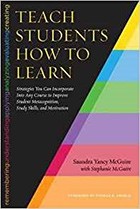 McGuire, S. Y., & McGuire, S. (2015). Teach students how to learn: Strategies you can incorporate into any course to improve student metacognition, study skills, and motivation.
McGuire, S. Y., & McGuire, S. (2015). Teach students how to learn: Strategies you can incorporate into any course to improve student metacognition, study skills, and motivation.
 Lang, J.M. (2016). Small teaching: Everyday lessons from the science of learning. San Francisco, CA: Jossey-Bass.
Lang, J.M. (2016). Small teaching: Everyday lessons from the science of learning. San Francisco, CA: Jossey-Bass.
 Fink, L.D. (2003). Creating significant learning experiences: An integrated approaches to designing college courses. San Francisco, CA: Jossey-Bass.
Fink, L.D. (2003). Creating significant learning experiences: An integrated approaches to designing college courses. San Francisco, CA: Jossey-Bass.
Integrated course design; Fink, L.D., & IDEA Center. (2005).
The 21st-century syllabus: Tips for putting andragogy into practice; Lund, D. K., & Fornaciari, C. J. (October 01, 2014). Journal of Management Education.
Principles of instruction: Research-based strategies that all teachers should know; Rosenshine, B. (January 01, 2012). American Educator.
Books
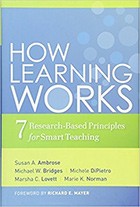 Ambrose, S.A., M.W. Bridges, M.C. Lovett, M. DiPietro, M.K. Norman. (2010). How learning works: 7 research-based principles for smart teaching. San Francisco, CA: Jossey-Bass.
Ambrose, S.A., M.W. Bridges, M.C. Lovett, M. DiPietro, M.K. Norman. (2010). How learning works: 7 research-based principles for smart teaching. San Francisco, CA: Jossey-Bass.
How Learning Works bridges learning-based research evidence to practices for improving college teaching. The authors specifically address seven learning principles, including prior student knowledge, student organization of knowledge, student motivation, mastery of skills, the influence of practice and feedback, the intersection of emotional, social and intellectual development as well as self-directed learning.
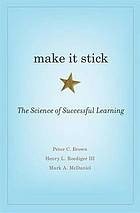 Brown, P.C., H.L. Roediger III & M.A. McDaniel (2014). Make it stick: The science of successful learning. Cambridge, MA: The Bellknap Press of Harvard University Press.
Brown, P.C., H.L. Roediger III & M.A. McDaniel (2014). Make it stick: The science of successful learning. Cambridge, MA: The Bellknap Press of Harvard University Press.
Make It Stick debunks common myths around best learning practices, and proposes that a long-term, repetitive process makes learning more effective. The authors explain that learning should be effortful and focused on the long-term retrieval of information built on prior knowledge, rather than the "cramming" or intensive "practice makes perfect" method.
 Cavanagh, S.R. (2016). The spark of learning: Energizing the college classroom with the science of emotion. Morgantown: West Virginia University Press.
Cavanagh, S.R. (2016). The spark of learning: Energizing the college classroom with the science of emotion. Morgantown: West Virginia University Press.
In friendly, readable prose, Sarah Rose Cavanagh argues that if you as an educator want to capture your students' attention, harness their working memory, bolster their long-term retention, and enhance their motivation, you should consider the emotional impact of your teaching style and course design. To make this argument, she brings to bear a wide range of evidence from the study of education, psychology, and neuroscience, and she provides practical examples of successful classroom activities from a variety of disciplines in secondary and higher education.
 Fink, L.D. (2003). Creating significant learning experiences: An integrated approaches to designing college courses. San Francisco, CA: Jossey-Bass.
Fink, L.D. (2003). Creating significant learning experiences: An integrated approaches to designing college courses. San Francisco, CA: Jossey-Bass.
L. Dee Fink writes this book in response to two main problems he has observed on college campuses: 1. the majority of learning goals focus on basic memorization; 2. despite a strong push for active learning in college classrooms, many instructors do not engage students beyond standard lectures and intermittent discussion.
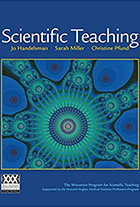 Handelsman, J., Miller, S., & Pfund, C. (2007). Scientific Teaching. New York: W.H. Freeman.
Handelsman, J., Miller, S., & Pfund, C. (2007). Scientific Teaching. New York: W.H. Freeman.
Seasoned classroom veterans, pre-tenured faculty, and neophyte teaching assistants alike will find this book invaluable. The authors of this book have distilled key findings from education, learning, and cognitive psychology and translated them into six chapters of digestible research points and practical classroom examples. Scientific Teaching is not a prescription for better teaching. Rather, it encourages the reader to approach teaching in a way that captures the spirit and rigor of scientific research and to contribute to transforming how students learn science.
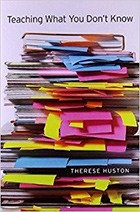 Hurston, T. (2009). Teaching what you don't know. Cambridge, MA: Harvard University Press.
Hurston, T. (2009). Teaching what you don't know. Cambridge, MA: Harvard University Press.
Therese Hurston, the Founding Director for the Center for Excellence in Teaching and Learning at Seattle University, wrote this book based on numerous interviews she conducted with university faculty across a variety of disciplines. In her interviews, she spoke with faculty members about the growing need to teach outside of one's academic expertise and how professors often feel only about "10 minutes ahead" of students in preparing for new classes.
 Lang, J.M. (2016). Small teaching: Everyday lessons from the science of learning. San Francisco, CA: Jossey-Bass.
Lang, J.M. (2016). Small teaching: Everyday lessons from the science of learning. San Francisco, CA: Jossey-Bass.
James Lang, English professor and director of the Center for Teaching Excellence at Assumption College, explains how small but powerful modifications in course design and teaching can yield positive results in higher ed settings. He groups these modifications into three broader categories: 5-10 minute classroom activities; one-time course interventions; and small modifications in course design or communication.
 McGuire, S. Y., & McGuire, S. (2015). Teach students how to learn: Strategies you can incorporate into any course to improve student metacognition, study skills, and motivation.
McGuire, S. Y., & McGuire, S. (2015). Teach students how to learn: Strategies you can incorporate into any course to improve student metacognition, study skills, and motivation.
For over a decade Saundra McGuire has been acclaimed for her presentations and workshops on metacognition and student learning because the tools and strategies she has shared have enabled faculty to facilitate dramatic improvements in student learning and success. The methods she proposes do not require restructuring courses, nor indeed an inordinate amount of time to teach; they can often be accomplished in a single session, transforming students from memorizers and regurgitators to students who begin to think critically and take responsibility for their own learning.
 Palmer, P. J. (2007). The courage to teach: Exploring the inner landscape of a teacher's life. San Francisco, CA: Jossey-Bass.
Palmer, P. J. (2007). The courage to teach: Exploring the inner landscape of a teacher's life. San Francisco, CA: Jossey-Bass.
While much scholarship on teaching and learning focuses on how students learn, Parker J. Palmer, renowned author, activist and founder of the Center for College and Renewal, writes The Courage to Teach in order to explore how the character of the teacher, and the inner life of the teacher, are crucial elements in the teaching and learning process.
 Schwartz, D.L., J.M. Tang, & K.P. Blair. (2016). The ABCs of how we learn. New York: Norton.
Schwartz, D.L., J.M. Tang, & K.P. Blair. (2016). The ABCs of how we learn. New York: Norton.
An explosive growth in research on how people learn has revealed many ways to improve teaching and catalyze learning at all ages. The purpose of The ABCs of How We Learn is to present this new science of learning so that educators can creatively translate the science into exceptional practice. Based on a popular Stanford University course, this book uses a novel format that is suitable as both a textbook and a popular read. With everyday language, engaging examples, a sense of humor, and solid evidence, it describes 26 unique ways that students learn.
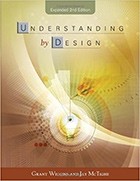 Wiggins, G. and J. McTighe. (2005). Understanding by design (2nd edition). Upper Saddle River, NJ: Pearson Education, Inc.
Wiggins, G. and J. McTighe. (2005). Understanding by design (2nd edition). Upper Saddle River, NJ: Pearson Education, Inc.
Grant Wiggins and Jay McTighe introduce the concept of backward design to curriculum development in Understanding by Design as the "UbD model" of backward design. The UbD model encourages instructors to begin their course planning with learning outcomes in mind and to then fit the lectures, activities and materials around these desired learning outcomes.
Articles
Allen, D., and K. Tanner. (2005). Infusing Active Learning into the Large-enrollment biology Class: Seven Strategies, from Simple to Complex. Cell Biology Education 4:262-268.
"Educators who have addressed the multitude of issues that underlie implementation of active-learning strategies in large-enrollment settings are conscientiously spreading the word to the science education community by presenting at conferences or publishing in science education journals. In this article, the authors focus on the large-class setting, providing an overview of tried-and-true approaches for incorporating active learning, ranging from the simple to complex. "
Bridging the pathway from instruction to research.
Batzli, J. M., Ebert-May, D., & Hodder, J. (2006). Bridging the pathway from instruction to research. Frontiers in Ecology and the Environment, 4(2), 105-107.
"The challenge for many faculty who have changed their courses is to determine if the innovations actually improve student learning. This leads some faculty towards research models that require empirical evidence based on student assessment data. Here we describe a framework for research on scientific teaching."
An empirical study comparing gamification and social networking on e-learning
de-Marcos, L., Domínguez, A., Saenz-de-Navarrete, J., & Pagés, C. (June 01, 2014). An empirical study comparing gamification and social networking on e-learning. Computers & Education, 75, 82-91.
"While social networking has already demonstrated its efficiency in e-learning, gamification, which is the use of game-thinking and playful design in non-game contexts, has only shown its potential as a motivational tool. This paper presents the results of testing both social networking and gamification in an undergraduate course, comparing them in terms their effect on students' academic achievement, participation and attitude."
Fink, L.D., & IDEA Center. (2005). Integrated course design. IDEA Paper #42. IDEA Center, Inc. 301 South Fourth Street Suite 200, Manhattan, KS 66502. Tel: 800-255-2757; Tel: 785-320-2400; e-mail: info@IDEAedu.org; Web site: http://ideaedu.org.
This paper outlines the key ideas and components of the model presented in L. Dee Fink's book, Creating Significant Learning Experiences: An Integrated Approach to Designing College Courses.
Active learning increases student performance in science, engineering, and mathematics.
Freeman, S., Eddy, S. L., McDonough, M., Smith, M. K., Okoroafor, N., Jordt, H., & Wenderoth, M. P. (2014). Active learning increases student performance in science, engineering, and mathematics. Proceedings of the National Academy of Sciences, 111(23), 8410-8415.
"This is the largest and most comprehensive metaanalysis of undergraduate STEM education published to date. The results raise questions about the continued use of traditional lecturing as a control in research studies, and support active learning as the preferred, empirically validated teaching practice in regular classrooms."
The 21st-century syllabus: Tips for putting andragogy into practice
Lund, D. K., & Fornaciari, C. J. (October 01, 2014). The 21st-century syllabus: Tips for putting andragogy into practice. Journal of Management Education, 38, 5, 724-732.
"Readers (are offered) seven concrete and practical tips to help them develop their own andragogically-inspired syllabi. We expect that instructors could adapt some, or all, of these tips in unique and interesting ways to best suit their own teaching styles and student learning objectives."
Principles of instruction: Research-based strategies that all teachers should know
Rosenshine, B. (January 01, 2012). Principles of instruction: Research-based strategies that all teachers should know. (Report). American Educator, 36, 1.
This article presents 10 research-based principles of instruction, along with suggestions for classroom practice. These principles come from three sources: (a) research in cognitive science, (b) research on master teachers, and (c) research on cognitive supports.
Preparing an effective syllabus: Current best practices
Slattery, J. M., & Carlson, J. F. (December 07, 2005). Preparing an effective syllabus: Current best practices. College Teaching, 53, 4, 159.
"Syllabi can be useful in engaging students and creating an effective classroom atmosphere, yet discussions of their effective use rarely appear. In light of current research and theory on syllabi, we review their typical uses (structural, motivational, and evidentiary), commonly included components, and attributes that positively impact the teaching and learning process."
